Top ratings
Get free trial access now Try first, then study!
4.92/5.0 (from 386 Trusted Shops Reviews )
4.9/5.0
- Google reviews


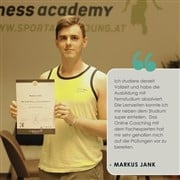

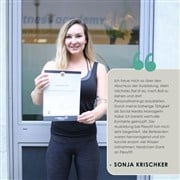
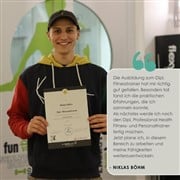
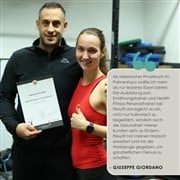
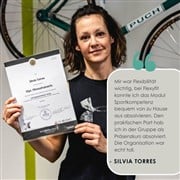
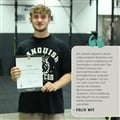

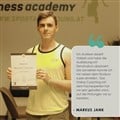


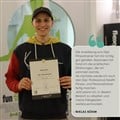
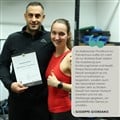
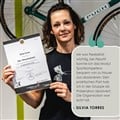

starting at €2.590,- | face-to-face course
» Our Course Packages
Flexible learning - our possible learning options for the course:
Recognized & Certified
Our graduates, partners & friends say
Our team will be happy to advise you at any time by phone, chat or in person
Extent of learning
648 E
EQF level
The training is based on EQF level 4 »
Course start
Possible immediately
Learning variant
Classroom Courses

| 19-07-2025 | starting at 2.590,-

Many people only have the time to enjoy their lives and pursue the activities they have always wanted to do when they retire. Unfortunately, many people's bodies can no longer keep up. Loss of strength, restricted movement, memory problems and more limit seniors in their freedom.
As a senior trainer, you work with older people who want to maintain or regain their ability to exercise. Through targeted training, you can help these people to counteract a loss of function in old age.
In the basic module, we will first deal with anatomical, physiological and training science basics. Nutrition-specific topics, professional knowledge and first aid for sports injuries also play an important role in our training program.
In the senior trainer module, for example, you will learn how to plan effective endurance training in order to reduce functional decline in old age. For example, age-appropriate tests are carried out to determine fitness levels, which are then used to plan target group-specific training interventions.
In order to be able to offer your clients optimal training later on, you will learn about all relevant types of training, such as pelvic floor training, mobility training and spinal gymnastics. You will learn how to use gymnastics to improve mobility problems and delve into the area of strength training for the elderly using small and large equipment.We will look at training for various illnesses and take a closer look at special nutrition in old age. Learning in old age, memory training as well as psychology and support in old age will also be an essential part of this module. After your training, you will be perfectly prepared to work as a trainer for senior citizens and will be able to provide them with comprehensive support in the areas of training, prevention and nutrition.
Our certificates are valid worldwide and are issued in different versions. On request, you can receive our certificate in several languages (DE, EN, ES), with country-specific information and with or without printed grades.
All these variants are available to you free of charge for a lifetime for downloading from your online campus. In addition, depending on the learning package you have purchased, you will receive a certificate of your choice, which will be issued on special high-quality embossed paper.
The following certificate (in several languages DE, EN, ES) will be awarded:
We are happy to help you by phone, e-mail or chat. However, you may find the answer to your question in our senior trainer FAQ.
You start your training with the basic module Sports Competence. You will learn theoretical knowledge from videos and scripts in 8 subjects, completing each subject with a short multiple-choice online exam.
You then move on to your subject specialization, i.e. your chosen course.
As our training courses are designed to be very flexible, the duration of the course depends heavily on your own learning initiative, the amount of time you spend each week and your previous knowledge.
You can start the basic sports competence module online at any time. This not only bridges the waiting time until the face-to-face lessons, but also allows you to acquire important basic knowledge.
You will learn in a group of 5 to 15 people in practice-oriented face-to-face lessons. Instructors teach you what you need to know as a trainer and support you with valuable tips for your day-to-day work.
You earn your grade with practical exercises and voluntary additional tasks. These exercises can range from training protocols and written assignments to filming exercises.
During your training, you can expect both multiple choice online intermediate exams and a final exam in person.
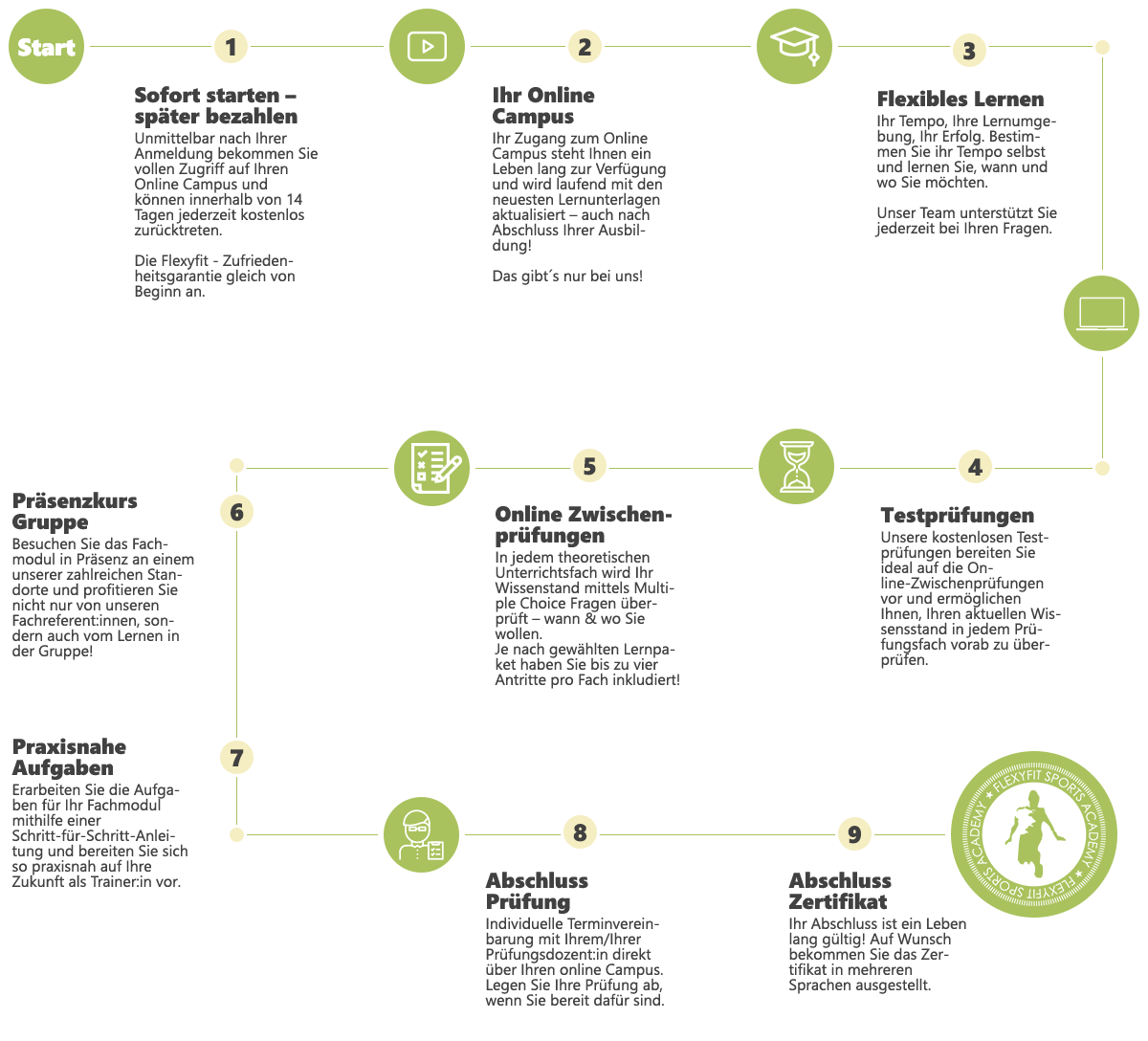
Extent of learning
200
Sports expertise
410
Presence | Self-study
6
Literature research
30
Practical realization
2
Additional tasks & examinations
This course is ideal for educational leave. Individual assessment and approval is carried out by the respective funding body. We will be happy to provide you with detailed information on the duration and procedure of educational leave. Contact us to arrange a consultation!
Participation in the face-to-face webinars is mandatory for educational leave and must be proven to the AMS. The participant is responsible for requesting confirmation of attendance. Confirmation of attendance of the face-to-face webinar will only be issued during each webinar if requested by the participant.
Show all chapters of the subjects

We educate the best trainers in the fitness branch. From start to finish of the education - and beyond!- we support and guide our students.
Functional anatomy is a foundation necessary for all trainers in exercise, fitness and sports. This subject provides a comprehensive introduction to the anatomy of the human body and a wellspring of important knowledge.
The course is constructed to present the information in an interesting and comprehensible manner and features different learning approaches appropriate for Fitness and Personal Trainers.
The goal is, to understand the relationship between movement patterns, the human body and relevant anatomical terminology.
Show chapter

Show chapter

Show chapter

More and more companies are integrating Corporate Wellness and similar health initiatives into their employee benefits packages. By doing so they promote the health and well-being of their employees, reducing the incidence of sick-leave and building healthier, stronger team dynamics.
Exactly why such initiatives are important is discussed in this introduction to the concept, as well as challenges that such initiatives face including organisational dysfunction.
Participants also learn about the advantages of corporate wellness and some trusted approaches and tools for finding and working with a company.
We offer suggestions on how to approach companies about Corporate Wellness, how to develop a corporate wellness concept and important organisational points to consider.
Participants will be exposed to some practical examples and will have the possiblity to perform group work on the topic.
Show chapter

The unit on Marketing and Customer Interaction gives participants some insight into identifying, working with and marketing to their ideal customer. This is one of the most useful units for the aspiring trainer, as it helps them identify their place in the market, which makes for a more successful career start.
We begin by taking a look at Marketing itself to understand exactly what it is and of what relevance it has for personal trainers.
Important basic concepts such as USP, positioning, target market, etc. are introduced and different models from marketing such as the SMART Formula, marketing mix (7Ps) and more are explained.
The communication between trainer and client is also addressed in this unit. Various aspects of communication theory and some guidelines for successful communication are covered.
Upon completion of this subject, participants are able to develop marketing strategies for their product and/or services, ready to position themselves in a market rich in variety and full of possibility!
Show chapter

A working understanding of human physiology and therefore the relationships between the various functions of the human body is crucial for anyone working in the exercise and fitness field. It is a requisite knowledge for the sufficient practice of their profession.
This course makes the relationships within the human organism graspable for everyone. Take a deep-dive into the human body and learn the functions of our organism for your new profession in fitness.
In this subject you will get a close look at energy metabolism needed for muscle activation, the circulatory system and the pulmonary system.
Any high quality education in fitness and exercise begins with the foundations of anatomy and physiology.
Show chapter

In this unit participants are prepared for successful communication with their clients on every level. In addition, we take a look at how the trainer or coach can go about dealing with their own goals and motives, which will in turn help them better understand their clients.
The right goal-setting and the proper approach to feedback are an important parts of this unit.
The way we manage stress as trainers and with our clients and a variety of learning strategies are explored so these skills can be integrated into your professional approach.
Show chapter

In this introduction to training theory we look at the foundations of training plan creation and management, including the principles of training, training methodology and factors that influence sports performance.
Because performance capacity, performance diagnostics, training and competition are so interrelated, they are covered together in this unit.
The second half of this unit Im zweiten Teil der Trainingslehre wird das Training als komplexer Handlungsprozess und im Zusammenhang mit Planung, Ausführung und Evaluation definiert und bewertet.
Ein wichtiger Teil der Trainingslehre ist nach wie vor die Trainingsplangestaltung, die mit Beispielen über die Möglichkeiten einer Trainingsplangestaltung praktisch vermittelt werden.
Um das Thema der Trainingswissenschaft zu vertiefen, laden wir regelmäßig internationale Top-Dozenten wie Univ. Prof. Dr. Paul Haber und Prof.em. Dr.phil. Dr.med. Dr. hc Jürgen Weineck zu uns in die Academy ein.
Unter anderem sind sie für die Bücher "Optimales Training" (Jürgen Weineck) und "Leistungsphysiologie" (Paul Haber) in der Trainingswissenschaft bekannt.
Show chapter
Show all chapters of the subjects

This unit on endurance training in old age teaches participants in a practical and understandable way how targeted endurance training can improve the health and quality of life of older people. Participants learn which physiological changes need to be taken into account in old age and how to design endurance training in an age-appropriate and safe way .
In addition to theoretical knowledge about training methods and load control, the focus is also on specific exercise units, training plan creation and motivation techniques. The aim is to optimally prepare trainers to help senior citizens achieve more exercise, health and independence .
BASICS OF ENDURANCE TRAINING IN OLD AGE
Show chapter

In the mobility training & mobility course, participants gain a practical understanding of the importance of mobility in old age. Physical changes and their influence on mobility, health and independence are discussed, with a particular focus on joint function and muscular flexibility .
With the help of targeted exercises for mobilization and stretching, participants learn how to design age-appropriate movement units for everyday life or group training. Particular attention is paid to functional transfer in everyday situations, for example when standing up, reaching or turning.
The subject concludes with the development of a separate unit on the topic of mobility for senior citizens and therefore provides an ideal basis for working with older people - both in the preventative area and in health-promoting group training.
Show chapter

This specialist module is dedicated to the special requirements of nutrition in old age - a key topic for all those who want to provide health-conscious support to senior citizens. Participants learn how physiological needs change with increasing age. A slower metabolism, a reduced energy intake combined with a high need for vitamins, minerals and proteins as well as a decreasing sensation of thirst are particular challenges.
In addition to theoretical knowledge about critical nutrients, common deficiency symptoms, age-related changes in digestion and loss of appetite, the course also focuses on practical implementation in the everyday lives of older people. Easily digestible, nutrient-dense foods, the importance of regular meals and the consideration of individual health restrictions (e.g. diabetes, chewing and swallowing difficulties) are discussed.
Another focus is on empathetic communication about nutrition in old age and the clear distinction between this and nutritional therapy advice. Case studies and practice-oriented tasks round off the module and make it a valuable basis for working with an ever-growing target group.
Show chapter

In the Functional Movement Analysis course unit, the focus is on the quality of everyday movements in old age. Participants learn to recognize and systematically analyse typical movement and posture patterns of older people, such as reduced arm swing, balance weaknesses or gait instability.
In addition to practical observation, they will learn how to safely carry out and evaluate functional tests such as the "chair-rise test" or the "timed-up-and-go test". From this, targeted training measures can be derived to improve mobility, strength and coordination in everyday life.
Particular attention is paid to formulating individual training goals from real everyday movements such as getting up from a chair, walking or reaching for objects and creating a mini-training plan based on these observations. This practice-oriented unit creates the basis for effective and needs-oriented training planning for older people.
Show chapter

In the Health Benefits of Exercise unit, participants learn how regular exercise not only increases physical performance, but also has numerous health benefits. The focus is on the positive effects on the cardiovascular system, the immune system and mental health.
The course sheds light on how targeted training can be used to prevent lifestyle diseases such as diabetes mellitus, osteoporosis and depression. Participants will learn which forms of training are particularly suitable for promoting general health and what to look out for in different target groups.
In addition, specific case studies are played through and practical methods for motivating customers are presented in order to integrate exercise into everyday life in the long term and ensure sustainable health-promoting effects.
Show chapter

Numerous studies have shown that a well-trained core contributes significantly to stability, fall prevention and healthy posture. This is exactly where the Integrated Core Training class comes in. Participants learn why a stable core, which consists of the pelvic floor, deep abdominal and back muscles and the diaphragm, is crucial for posture, balance and safe movement.
The units cover key topics such as pelvic floor training, targeted core stabilization on stable and unstable surfaces and integration into everyday movement sequences . The focus is particularly on age-appropriate implementation: the exercises are gentle, functional and individually scalable - ideal for working with older people.
Among other things, participants learn how incontinence, instability and the risk of falling can be reduced through targeted core training. In addition to many practical exercise examples, aspects such as breathing control, exercise guidance and training structure are also taught. An ideal module for anyone who wants to combine functional, health-oriented training with clear relevance to everyday life.
Show chapter

Strength training is an essential component of health promotion, injury prevention and performance enhancement. The integrated strength training module covers the three main forms of training: equipment, small equipment and outdoor training.
The focus is on targeted strengthening of the upper and lower extremities as well as the core muscles, tailored to the needs of older people. In addition to the safe use of classic training equipment such as the leg press or the rowing machine, the functional use of Therabands, dumbbells and everyday objects is also taught.
Special emphasis is placed on suitability for everyday use: the focus is on exercises to prevent falls, to promote walking safety and to cope with typical everyday situations such as standing up or carrying. Participants also learn how to design individual strength circuits and adapt training concepts to different performance levels.
Show chapter

Coordination is the basis for the safe and efficient execution of movements. It is becoming increasingly important, especially for older people. In coordination training, the six basic coordinative abilities - balance, reaction, rhythm, coupling, differentiation and orientation - are therefore systematically dealt with and their interplay analyzed.
A particular focus is placed on age-related physiological changes such as the decline in sensory abilities, delayed reaction times and a decrease in the ability to balance. Scientific findings are used to show which coordinative requirements are particularly challenging in old age and how they affect mobility and everyday competence.
The course goes on to show how coordination is linked to cognitive and motor requirements and how these can be specifically trained in old age, for example to prevent falls or promote responsiveness. Neurophysiological principles such as the role of the central nervous system in controlling movement sequences are also taken into account.
Show chapter

The ageing process affects almost all body systems and is accompanied by physiological changes and an increased susceptibility to certain diseases. This subject focuses on central aspects of geriatrics, in particular changes in the cardiovascular, respiratory, musculoskeletal, nervous and metabolic systems.
Building on this, there is a comprehensive introduction to common age-related diseases such as hypertension, type 2 diabetes mellitus, osteoarthritis, osteoporosis and neurodegenerative diseases such as Parkinson's or dementia. The aim is to develop a sound understanding of the development, symptoms and relevance of these diseases in the context of exercise and training in old age.
Participants learn the essential basics for recognizing health-related restrictions in older people and taking them into account accordingly - always within the scope of their professional competence.
Show chapter

Falls are one of the most common causes of accidents in old age and often have considerable health, psychological and social consequences. The participants deal with scientifically based risk factors for falls as well as epidemiological data on their frequency and relevance in old age.
A central topic is the classification of risk factors into extrinsic (e.g. environmental factors, use of aids) and intrinsic factors (e.g. muscle strength, balance, neurological diseases). In addition, the connection between common geriatric diseases such as osteoarthritis, osteoporosis, dementia and Parkinson's disease and the risk of falling is explained.
It also shows which preventive measures can be used effectively through targeted exercise promotion. The content is based on current guidelines and evidence-based approaches to fall prevention and also takes into account psychological aspects such as fear of falling and its influence on mobility behavior.
Show chapter

Physiological processes change with increasing age: Muscle mass and strength decrease, reaction times lengthen and the regeneration time increases. This is precisely where the training theory lesson specifically for senior citizens comes in. It provides in-depth knowledge about the effects of training in old age, how they can be specifically promoted and why adapted training is essential for independence, fall prevention and cognitive performance.
Participants will learn about key training principles and methods for age-appropriate load control. Particular attention is paid to heart rate control, the Borg scale and the correct dosage of repetitions, sets and breaks. In addition to theory, relevant types of training such as strength, endurance, flexibility and coordination training are also covered with regard to everyday use in older people. Finally, it shows how a training session can be structured sensibly and individually adapted to the performance level - from the definition of goals to the selection of exercises and appropriate differentiation.
Show chapter
The basic module Sports Competence is approved by the German Central Agency for Distance Learning (ZFU) under the following number: 7324018c. The ZFU is the central authority for distance learning in Germany and works on the basis of the Distance Learning Protection Act (FernUSG). It decides on the approval of distance learning courses nationwide in order to guarantee a technically correct and generally professional distance learning course.
As a recognized institution in adult education, our curricula are regularly evaluated and recognized by state institutions and funding bodies. We are constantly striving to exceed current quality standards in order to guarantee you the best possible training. Convince yourself of our certifications.
There are a variety of funding options for training at the Flexyfit Sports Academy. State-specific and EU funding as well as tax-related options form the basis for this.
However, we would like to point out that the respective funding body is solely responsible for deciding on the allocation or amount of funding.
We will be happy to help you find a suitable funding body and compile all the course information you need for a funding application. You must submit the application itself to the funding body.
You can find an overview of the most important funding bodies here.
Depending on the funding institution, the training costs are either paid directly after the funding application has been confirmed (e.g. AMS) or reimbursed in full or in part after successful completion of the training (e.g. waff). Please contact the funding institutions yourself to find out how the funding works.
Yes, the majority of our courses are suitable for educational leave.
If you want to continue your education without terminating your employment, you can arrange educational leave with your employer. This means you will be released from work for the duration of your training.
Plan your educational leave with us now! We will be happy to clarify your individual training requirements with you in a personal, non-binding consultation.
You can take your educational leave for a maximum of 1 year within 4 years - there are 3 options:
It is important that your employer agrees to you taking educational leave. You must provide evidence of the training plans issued by us to the extent of 20 hours per week in the case of full-time educational leave, or at least 10 hours in the case of part-time educational leave.
You must regularly provide evidence of the progress of your training. For example, in the form of examinations or confirmation of attendance, which you will receive from us.
As a senior trainer, you develop training that is optimally adapted to the needs and physical capabilities of older people. With a mix of strength, endurance, flexibility and coordination training, the training serves to reduce functional loss in old age.
A senior trainer also addresses various illnesses of senior citizens and deals with special nutrition in old age. Memory training is also an essential part of this sports specialization.
We regularly list job advertisements from fitness studios on our Sportkarriere platform. There you can apply directly for jobs as a fitness trainer, branch manager, instructor or studio employee.

Many people only have the time to enjoy their lives and pursue the activities they have always wanted to do when they retire. Unfortunately, many people's bodies can no longer keep up. Loss of strength, restricted movement, memory problems and more limit seniors in their freedom.
As a senior trainer, you work with older people who want to maintain or regain their ability to exercise. Through targeted training, you can help these people to counteract a loss of function in old age.
In the basic module, we will first deal with anatomical, physiological and training science basics. Nutrition-specific topics, professional knowledge and first aid for sports injuries also play an important role in our training program.
In the senior trainer module, for example, you will learn how to plan effective endurance training in order to reduce functional decline in old age. For example, age-appropriate tests are carried out to determine fitness levels, which are then used to plan target group-specific training interventions.
In order to be able to offer your clients optimal training later on, you will learn about all relevant types of training, such as pelvic floor training, mobility training and spinal gymnastics. You will learn how to use gymnastics to improve mobility problems and delve into the area of strength training for the elderly using small and large equipment.We will look at training for various illnesses and take a closer look at special nutrition in old age. Learning in old age, memory training as well as psychology and support in old age will also be an essential part of this module. After your training, you will be perfectly prepared to work as a trainer for senior citizens and will be able to provide them with comprehensive support in the areas of training, prevention and nutrition.
Our certificates are valid worldwide and are issued in different versions. On request, you can receive our certificate in several languages (DE, EN, ES), with country-specific information and with or without printed grades.
All these variants are available to you free of charge for a lifetime for downloading from your online campus. In addition, depending on the learning package you have purchased, you will receive a certificate of your choice, which will be issued on special high-quality embossed paper.
The following certificate (in several languages DE, EN, ES) will be awarded:
We are happy to help you by phone, e-mail or chat. However, you may find the answer to your question in our senior trainer FAQ.
You start your training with the basic module Sports Competence. You will learn theoretical knowledge from videos and scripts in 8 subjects, completing each subject with a short multiple-choice online exam.
You then move on to your subject specialization, i.e. your chosen course.
As our training courses are designed to be very flexible, the duration of the course depends heavily on your own learning initiative, the amount of time you spend each week and your previous knowledge.
You can start the basic sports competence module online at any time. This not only bridges the waiting time until the face-to-face lessons, but also allows you to acquire important basic knowledge.
You will learn in a group of 5 to 15 people in practice-oriented face-to-face lessons. Instructors teach you what you need to know as a trainer and support you with valuable tips for your day-to-day work.
You earn your grade with practical exercises and voluntary additional tasks. These exercises can range from training protocols and written assignments to filming exercises.
During your training, you can expect both multiple choice online intermediate exams and a final exam in person.

Extent of learning
200
Sports expertise
410
Presence | Self-study
6
Literature research
30
Practical realization
2
Additional tasks & examinations
This course is ideal for educational leave. Individual assessment and approval is carried out by the respective funding body. We will be happy to provide you with detailed information on the duration and procedure of educational leave. Contact us to arrange a consultation!
Participation in the face-to-face webinars is mandatory for educational leave and must be proven to the AMS. The participant is responsible for requesting confirmation of attendance. Confirmation of attendance of the face-to-face webinar will only be issued during each webinar if requested by the participant.
Show all chapters of the subjects

We educate the best trainers in the fitness branch. From start to finish of the education - and beyond!- we support and guide our students.
Functional anatomy is a foundation necessary for all trainers in exercise, fitness and sports. This subject provides a comprehensive introduction to the anatomy of the human body and a wellspring of important knowledge.
The course is constructed to present the information in an interesting and comprehensible manner and features different learning approaches appropriate for Fitness and Personal Trainers.
The goal is, to understand the relationship between movement patterns, the human body and relevant anatomical terminology.
Show chapter

Show chapter

Show chapter

More and more companies are integrating Corporate Wellness and similar health initiatives into their employee benefits packages. By doing so they promote the health and well-being of their employees, reducing the incidence of sick-leave and building healthier, stronger team dynamics.
Exactly why such initiatives are important is discussed in this introduction to the concept, as well as challenges that such initiatives face including organisational dysfunction.
Participants also learn about the advantages of corporate wellness and some trusted approaches and tools for finding and working with a company.
We offer suggestions on how to approach companies about Corporate Wellness, how to develop a corporate wellness concept and important organisational points to consider.
Participants will be exposed to some practical examples and will have the possiblity to perform group work on the topic.
Show chapter

The unit on Marketing and Customer Interaction gives participants some insight into identifying, working with and marketing to their ideal customer. This is one of the most useful units for the aspiring trainer, as it helps them identify their place in the market, which makes for a more successful career start.
We begin by taking a look at Marketing itself to understand exactly what it is and of what relevance it has for personal trainers.
Important basic concepts such as USP, positioning, target market, etc. are introduced and different models from marketing such as the SMART Formula, marketing mix (7Ps) and more are explained.
The communication between trainer and client is also addressed in this unit. Various aspects of communication theory and some guidelines for successful communication are covered.
Upon completion of this subject, participants are able to develop marketing strategies for their product and/or services, ready to position themselves in a market rich in variety and full of possibility!
Show chapter

A working understanding of human physiology and therefore the relationships between the various functions of the human body is crucial for anyone working in the exercise and fitness field. It is a requisite knowledge for the sufficient practice of their profession.
This course makes the relationships within the human organism graspable for everyone. Take a deep-dive into the human body and learn the functions of our organism for your new profession in fitness.
In this subject you will get a close look at energy metabolism needed for muscle activation, the circulatory system and the pulmonary system.
Any high quality education in fitness and exercise begins with the foundations of anatomy and physiology.
Show chapter

In this unit participants are prepared for successful communication with their clients on every level. In addition, we take a look at how the trainer or coach can go about dealing with their own goals and motives, which will in turn help them better understand their clients.
The right goal-setting and the proper approach to feedback are an important parts of this unit.
The way we manage stress as trainers and with our clients and a variety of learning strategies are explored so these skills can be integrated into your professional approach.
Show chapter

In this introduction to training theory we look at the foundations of training plan creation and management, including the principles of training, training methodology and factors that influence sports performance.
Because performance capacity, performance diagnostics, training and competition are so interrelated, they are covered together in this unit.
The second half of this unit Im zweiten Teil der Trainingslehre wird das Training als komplexer Handlungsprozess und im Zusammenhang mit Planung, Ausführung und Evaluation definiert und bewertet.
Ein wichtiger Teil der Trainingslehre ist nach wie vor die Trainingsplangestaltung, die mit Beispielen über die Möglichkeiten einer Trainingsplangestaltung praktisch vermittelt werden.
Um das Thema der Trainingswissenschaft zu vertiefen, laden wir regelmäßig internationale Top-Dozenten wie Univ. Prof. Dr. Paul Haber und Prof.em. Dr.phil. Dr.med. Dr. hc Jürgen Weineck zu uns in die Academy ein.
Unter anderem sind sie für die Bücher "Optimales Training" (Jürgen Weineck) und "Leistungsphysiologie" (Paul Haber) in der Trainingswissenschaft bekannt.
Show chapter
Show all chapters of the subjects

This unit on endurance training in old age teaches participants in a practical and understandable way how targeted endurance training can improve the health and quality of life of older people. Participants learn which physiological changes need to be taken into account in old age and how to design endurance training in an age-appropriate and safe way .
In addition to theoretical knowledge about training methods and load control, the focus is also on specific exercise units, training plan creation and motivation techniques. The aim is to optimally prepare trainers to help senior citizens achieve more exercise, health and independence .
BASICS OF ENDURANCE TRAINING IN OLD AGE
Show chapter

In the mobility training & mobility course, participants gain a practical understanding of the importance of mobility in old age. Physical changes and their influence on mobility, health and independence are discussed, with a particular focus on joint function and muscular flexibility .
With the help of targeted exercises for mobilization and stretching, participants learn how to design age-appropriate movement units for everyday life or group training. Particular attention is paid to functional transfer in everyday situations, for example when standing up, reaching or turning.
The subject concludes with the development of a separate unit on the topic of mobility for senior citizens and therefore provides an ideal basis for working with older people - both in the preventative area and in health-promoting group training.
Show chapter

This specialist module is dedicated to the special requirements of nutrition in old age - a key topic for all those who want to provide health-conscious support to senior citizens. Participants learn how physiological needs change with increasing age. A slower metabolism, a reduced energy intake combined with a high need for vitamins, minerals and proteins as well as a decreasing sensation of thirst are particular challenges.
In addition to theoretical knowledge about critical nutrients, common deficiency symptoms, age-related changes in digestion and loss of appetite, the course also focuses on practical implementation in the everyday lives of older people. Easily digestible, nutrient-dense foods, the importance of regular meals and the consideration of individual health restrictions (e.g. diabetes, chewing and swallowing difficulties) are discussed.
Another focus is on empathetic communication about nutrition in old age and the clear distinction between this and nutritional therapy advice. Case studies and practice-oriented tasks round off the module and make it a valuable basis for working with an ever-growing target group.
Show chapter

In the Functional Movement Analysis course unit, the focus is on the quality of everyday movements in old age. Participants learn to recognize and systematically analyse typical movement and posture patterns of older people, such as reduced arm swing, balance weaknesses or gait instability.
In addition to practical observation, they will learn how to safely carry out and evaluate functional tests such as the "chair-rise test" or the "timed-up-and-go test". From this, targeted training measures can be derived to improve mobility, strength and coordination in everyday life.
Particular attention is paid to formulating individual training goals from real everyday movements such as getting up from a chair, walking or reaching for objects and creating a mini-training plan based on these observations. This practice-oriented unit creates the basis for effective and needs-oriented training planning for older people.
Show chapter

In the Health Benefits of Exercise unit, participants learn how regular exercise not only increases physical performance, but also has numerous health benefits. The focus is on the positive effects on the cardiovascular system, the immune system and mental health.
The course sheds light on how targeted training can be used to prevent lifestyle diseases such as diabetes mellitus, osteoporosis and depression. Participants will learn which forms of training are particularly suitable for promoting general health and what to look out for in different target groups.
In addition, specific case studies are played through and practical methods for motivating customers are presented in order to integrate exercise into everyday life in the long term and ensure sustainable health-promoting effects.
Show chapter

Numerous studies have shown that a well-trained core contributes significantly to stability, fall prevention and healthy posture. This is exactly where the Integrated Core Training class comes in. Participants learn why a stable core, which consists of the pelvic floor, deep abdominal and back muscles and the diaphragm, is crucial for posture, balance and safe movement.
The units cover key topics such as pelvic floor training, targeted core stabilization on stable and unstable surfaces and integration into everyday movement sequences . The focus is particularly on age-appropriate implementation: the exercises are gentle, functional and individually scalable - ideal for working with older people.
Among other things, participants learn how incontinence, instability and the risk of falling can be reduced through targeted core training. In addition to many practical exercise examples, aspects such as breathing control, exercise guidance and training structure are also taught. An ideal module for anyone who wants to combine functional, health-oriented training with clear relevance to everyday life.
Show chapter

Strength training is an essential component of health promotion, injury prevention and performance enhancement. The integrated strength training module covers the three main forms of training: equipment, small equipment and outdoor training.
The focus is on targeted strengthening of the upper and lower extremities as well as the core muscles, tailored to the needs of older people. In addition to the safe use of classic training equipment such as the leg press or the rowing machine, the functional use of Therabands, dumbbells and everyday objects is also taught.
Special emphasis is placed on suitability for everyday use: the focus is on exercises to prevent falls, to promote walking safety and to cope with typical everyday situations such as standing up or carrying. Participants also learn how to design individual strength circuits and adapt training concepts to different performance levels.
Show chapter

Coordination is the basis for the safe and efficient execution of movements. It is becoming increasingly important, especially for older people. In coordination training, the six basic coordinative abilities - balance, reaction, rhythm, coupling, differentiation and orientation - are therefore systematically dealt with and their interplay analyzed.
A particular focus is placed on age-related physiological changes such as the decline in sensory abilities, delayed reaction times and a decrease in the ability to balance. Scientific findings are used to show which coordinative requirements are particularly challenging in old age and how they affect mobility and everyday competence.
The course goes on to show how coordination is linked to cognitive and motor requirements and how these can be specifically trained in old age, for example to prevent falls or promote responsiveness. Neurophysiological principles such as the role of the central nervous system in controlling movement sequences are also taken into account.
Show chapter

The ageing process affects almost all body systems and is accompanied by physiological changes and an increased susceptibility to certain diseases. This subject focuses on central aspects of geriatrics, in particular changes in the cardiovascular, respiratory, musculoskeletal, nervous and metabolic systems.
Building on this, there is a comprehensive introduction to common age-related diseases such as hypertension, type 2 diabetes mellitus, osteoarthritis, osteoporosis and neurodegenerative diseases such as Parkinson's or dementia. The aim is to develop a sound understanding of the development, symptoms and relevance of these diseases in the context of exercise and training in old age.
Participants learn the essential basics for recognizing health-related restrictions in older people and taking them into account accordingly - always within the scope of their professional competence.
Show chapter

Falls are one of the most common causes of accidents in old age and often have considerable health, psychological and social consequences. The participants deal with scientifically based risk factors for falls as well as epidemiological data on their frequency and relevance in old age.
A central topic is the classification of risk factors into extrinsic (e.g. environmental factors, use of aids) and intrinsic factors (e.g. muscle strength, balance, neurological diseases). In addition, the connection between common geriatric diseases such as osteoarthritis, osteoporosis, dementia and Parkinson's disease and the risk of falling is explained.
It also shows which preventive measures can be used effectively through targeted exercise promotion. The content is based on current guidelines and evidence-based approaches to fall prevention and also takes into account psychological aspects such as fear of falling and its influence on mobility behavior.
Show chapter

Physiological processes change with increasing age: Muscle mass and strength decrease, reaction times lengthen and the regeneration time increases. This is precisely where the training theory lesson specifically for senior citizens comes in. It provides in-depth knowledge about the effects of training in old age, how they can be specifically promoted and why adapted training is essential for independence, fall prevention and cognitive performance.
Participants will learn about key training principles and methods for age-appropriate load control. Particular attention is paid to heart rate control, the Borg scale and the correct dosage of repetitions, sets and breaks. In addition to theory, relevant types of training such as strength, endurance, flexibility and coordination training are also covered with regard to everyday use in older people. Finally, it shows how a training session can be structured sensibly and individually adapted to the performance level - from the definition of goals to the selection of exercises and appropriate differentiation.
Show chapter
The basic module Sports Competence is approved by the German Central Agency for Distance Learning (ZFU) under the following number: 7324018c. The ZFU is the central authority for distance learning in Germany and works on the basis of the Distance Learning Protection Act (FernUSG). It decides on the approval of distance learning courses nationwide in order to guarantee a technically correct and generally professional distance learning course.
As a recognized institution in adult education, our curricula are regularly evaluated and recognized by state institutions and funding bodies. We are constantly striving to exceed current quality standards in order to guarantee you the best possible training. Convince yourself of our certifications.
There are a variety of funding options for training at the Flexyfit Sports Academy. State-specific and EU funding as well as tax-related options form the basis for this.
However, we would like to point out that the respective funding body is solely responsible for deciding on the allocation or amount of funding.
We will be happy to help you find a suitable funding body and compile all the course information you need for a funding application. You must submit the application itself to the funding body.
You can find an overview of the most important funding bodies here.
Depending on the funding institution, the training costs are either paid directly after the funding application has been confirmed (e.g. AMS) or reimbursed in full or in part after successful completion of the training (e.g. waff). Please contact the funding institutions yourself to find out how the funding works.
Yes, the majority of our courses are suitable for educational leave.
If you want to continue your education without terminating your employment, you can arrange educational leave with your employer. This means you will be released from work for the duration of your training.
Plan your educational leave with us now! We will be happy to clarify your individual training requirements with you in a personal, non-binding consultation.
You can take your educational leave for a maximum of 1 year within 4 years - there are 3 options:
It is important that your employer agrees to you taking educational leave. You must provide evidence of the training plans issued by us to the extent of 20 hours per week in the case of full-time educational leave, or at least 10 hours in the case of part-time educational leave.
You must regularly provide evidence of the progress of your training. For example, in the form of examinations or confirmation of attendance, which you will receive from us.
As a senior trainer, you develop training that is optimally adapted to the needs and physical capabilities of older people. With a mix of strength, endurance, flexibility and coordination training, the training serves to reduce functional loss in old age.
A senior trainer also addresses various illnesses of senior citizens and deals with special nutrition in old age. Memory training is also an essential part of this sports specialization.
We regularly list job advertisements from fitness studios on our Sportkarriere platform. There you can apply directly for jobs as a fitness trainer, branch manager, instructor or studio employee.

4.92/5.0 (from 386 Trusted Shops Reviews )

Available course variations
Language of Instruction
Course Module
Fitness Fundamentals
Fitness basics (presence)
Fitness Fundamentals Full HD Video Lessons
Specialist module Full HD learning videos for senior trainers
Course Module Full HD Video Lessons
Course Modality
Study Method
Auditory & Visual Learning Style
Communicative & Kinesthetic Learning Style
Study Timeframe
Text & Presentation PDFs
Lectures Bookable as Classroom Units
Support via Online Campus, E-mail, Chat, Tel.
WhatsApp & On-site Support
Test/Dummy Exam
NADA Austria
Altitude Training - Prof. Dr. Weineck
Fitness Fundamentals Theory Exams Online
Final Exam
Certificate in DE, EN or ES
Certificate accepted worldwide & never expires
Lifetime Access to Online Campus
Free Demo Account / Trial Package
Certificate Copy as Downloadable PDF
Certificate with Verification via QR-Code
Financial Aid/Grant Opportunities
Paid Educational Leave (AT)
Grants for Businesses
Grants for Self-Employed Persons
Course Advising
Cost Estimate for Financial Aid Provider
Job Openings Mailing List
Comprehensive Training Opportunities
Absolute Best Price & Service Offer
EN
online + expert discussion
online
optionally bookable
314
120
Online
visual
recommended
suited
flexible
bookable
flexible date
up to 100%
non-binding
EN
Classroom course group
online
optionally bookable
314
bookable
online/presence
visual/motoric
well suited
well suited
flexible + dates
bookable
flexible date
up to 100%
non-binding
DE, EN
private lessons
online
included
314
One2One
visual/motoric
suited
recommended
individual
included
individual
2
up to 100%
non-binding
2 weeks ago
Very well organized team, uncomplicated operation of online lessons, versatile informative script :) All in all top!
posted on
2 weeks ago
I am very impressed with Flexyfit, always nice and helpful people. Very sympathetic. Thank you very much for your great support.
posted on
3 weeks ago
Great training and super nice people. You can tell how much emphasis is placed on conveying the necessary knowledge to the course participants in an understandable way. I was even kindly allowed to take a course completely free of charge after there were somewhat problematic and disruptive participants in my group. I will 100% take more courses with you in the future because learning is extremely fun, especially thanks to the friendly staff!
posted on
3 weeks ago
The entire flexyfit team is extremely friendly, prompt and helpful. The lecturers are competent and respond to the course participants. All learning materials were provided clearly and in sufficient detail. The additional videos mean there is something for every type of learner. All in all, the training and exam went well. I can definitely recommend flexyfit and will be happy to book and recommend further training courses with you again!
posted on
a months ago
A great team - competent, friendly, always helpful and supportive - provided excellent support for the practical training. We recommend! :)
posted on
a months ago
Great support and extensive course content. We recommend!
posted on
a months ago
I really enjoyed training to become a B-license fitness trainer there. The teaching materials provided are great and flawless. I learned a lot of new things there and always enjoyed what I was doing. The team is great and is always there for you if you have any questions!
posted on
a month ago
The best thing that could have happened to me is this academy. Access to participants is excellent. All employees are very competent, very professional and very friendly. A person can learn so much that it is indescribably good. I would recommend it to everyone. When I arrived in Austria I was looking for something like this and luckily I found this academy and signed up for the course without hesitation. Everything we get in return is worth 100 times more than what we pay. Indescribable experience, indescribable people, once again and 1000 times I say: Thank you for everything, thank you for this indescribable experience. THANK YOU, THANK YOU, THANK YOU
posted on
a months ago
I was able to learn a lot of new things as part of my training at the Flexyfit Academy and was able to take on a new, demanding challenge with my chosen course. The structure of the training courses is very understandable and clear, so that you can master the distance learning course on your own without any problems. If there were any questions, ambiguities or isolated problems, the Academy team was always quick to help and we could always find a common solution. Here and there I would have liked a little more practical relevance. Nevertheless, I always felt very comfortable, had great speakers and with my degree as a qualified medical sports coach, many new doors are now open to me :)
posted on
2 months ago
I was able to complete my chosen course very well and quickly. The team is very quick and courteous and you are always offered a good solution if there are any uncertainties. I will book again when I get the chance and can recommend the academy!
posted on
Select your preferred course modality and find the fitness education that suits your interests

Please select a learning variant or enter a search text!

38.975 satisfied customers - from Austria and 13 other countries.